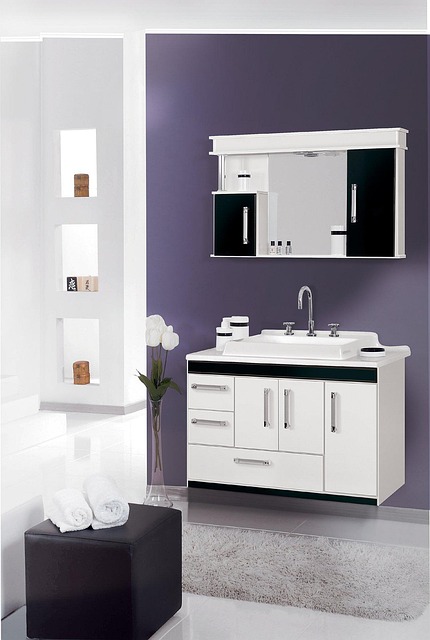In small bathroom renovations, proper ventilation is often overlooked but crucial for maintaining excellent air quality and preventing issues like mold growth and moisture buildup. Install high-efficiency exhaust fans in areas prone to moisture, use intake vents or open windows for fresh air, and regularly clean and maintain the ventilation system. Combining natural (windows/skylights) and mechanical (exhaust fans) ventilation solutions significantly enhances airflow, minimizes odors, controls moisture levels, prevents mold, and creates a healthier environment post-renovation. Regularly monitor vent and fan functionality and consider an air quality monitor for enhanced peace of mind.
Ensuring proper ventilation is crucial for maintaining air quality in small spaces, especially during renovations. In this comprehensive guide, we explore essential practices tailored to your small bathroom renovation. From understanding unique ventilation needs to implementing natural and mechanical solutions, we delve into best practices and common challenges like moisture buildup and poor air circulation. Learn how continuous monitoring and regular maintenance can create a healthier, more comfortable space.
Understanding Ventilation Needs in Small Spaces
In a small space like a bathroom undergoing a renovation, understanding ventilation needs is paramount to maintaining optimal air quality. While it might seem like a smaller area requires less airflow, this couldn’t be further from the truth. Even in compact spaces, proper ventilation is essential for several reasons. Firstly, it helps control humidity levels, preventing mold and mildew growth, which are not only unsightly but also hazardous to health. Secondly, adequate ventilation ensures that stale air is replaced with fresh outdoor air, reducing the buildup of potentially harmful gases and odors.
In a small bathroom renovation, focusing on strategic ventilation can make all the difference in creating a comfortable and healthy environment. This might involve installing high-efficiency exhaust fans or incorporating trickle vents into the design to allow for continuous air circulation. Additionally, considering the location of airflow sources and ensuring proper placement of fixtures and fittings can maximize the effectiveness of these ventilation solutions, thereby enhancing overall air quality.
Common Challenges with Poor Ventilation in Bathrooms
In small bathroom renovations, proper ventilation is often overlooked, leading to a host of issues. One of the primary challenges is the buildup of moisture and humidity. Without adequate air circulation, steam from showers and baths lingers, condensing on surfaces and contributing to mold growth behind walls and in corners. This not only compromises indoor air quality but also damages structural integrity over time. Additionally, poor ventilation results in a persistent smell of mildew and dampness, which can be discomforting for occupants and indicative of health risks associated with stale air.
Best Practices for Effective Ventilation During Renovations
When embarking on a small bathroom renovation, proper ventilation is often an overlooked yet critical aspect that can significantly impact air quality and overall comfort. During any renovation project, it’s essential to prioritize fresh air circulation to remove stagnant, potentially harmful gases and particles generated by construction activities.
Best practices include installing high-efficiency exhaust fans capable of handling the specific needs of a small space. These fans should be strategically placed in areas prone to moisture buildup, such as above showers or sinks. Additionally, ensuring adequate intake vents or opening windows during renovation can facilitate the entry of fresh air, further enhancing ventilation. Regular cleaning and maintenance of these ventilation systems are also crucial to keep them functioning optimally, thereby maintaining a healthy indoor environment post-renovation.
Incorporating Natural and Mechanical Ventilation Solutions
In a small space like a bathroom, a strategic blend of natural and mechanical ventilation solutions can significantly enhance air quality during a renovation. Natural ventilation relies on openings like windows and vents to allow fresh air in while expelling stale air. This approach leverages outside breezes and temperature differences for effective cooling and ventilating. For a small bathroom renovation, strategically placing windows or skylights in opposition to each other can create cross-ventilation, ensuring consistent airflow and minimizing the buildup of humid or foul odors.
Mechanical ventilation systems, on the other hand, offer more control over air movement and filtration. Exhaust fans, for instance, actively draw out stale air while bringing in fresh, filtered air from outside. These systems are particularly beneficial in keeping moisture levels under control during showers or baths, preventing mold growth and improving overall air quality. Combining these methods allows for both efficient airflow and the removal of pollutants, creating a healthier environment post-renovation.
Continuous Monitoring and Maintenance for Optimal Air Quality
Proper ventilation is an essential aspect of any small space renovation, especially in bathrooms where humidity and heat can build up quickly. Continuous monitoring is key to maintaining optimal air quality throughout your small bathroom renovation process. Regularly check that vents and fans are functioning correctly, ensuring they exhaust stale air and draw in fresh oxygen. This simple step goes a long way in preventing the accumulation of moisture and bacteria, which can lead to unpleasant odors and even mold growth.
For added peace of mind, invest in an air quality monitor specifically designed for bathrooms. These devices can alert you to any sudden changes in air composition, allowing you to take immediate action if necessary. Regular cleaning and maintenance of your ventilation system are also crucial. Dust, hair, and other particles can accumulate over time, reducing airflow efficiency and potentially impacting air quality. Keeping vents clear and filters clean ensures that your bathroom remains a healthy and pleasant environment after the renovation is complete.
A successful small bathroom renovation goes beyond aesthetics; it demands addressing ventilation as a key component of air quality management. By understanding the specific needs, implementing best practices, and combining natural with mechanical solutions, homeowners can create a comfortable and healthy space. Continuous monitoring and maintenance are vital to ensure optimal air quality, preventing issues associated with poor ventilation and enhancing the overall well-being of occupants.
